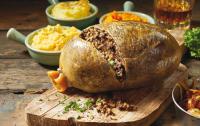Address to a Haggis
02 January 24
By Terry McCallum June 2023 edition of the Freemason
With Burns’ birthday being 25 January, a great number of masonic lodges use their January meeting to conduct a Burns Night, where haggis is piped into the South amid great ceremony and applause, only to be gutted mid-poem, displayed to all, toasted with a hearty shout and then ceremonially removed to the kitchen to be prepared for the Great Devouring.
Some background for the Sassenachs
Listed amongst our many famous masons is Robert ‘Rabbie’ Burns aka The Bard. Scots around the world speak of him with great pride, and he is widely seen as Scotland’s National Poet. In a poll conducted by Scottish TV in 2009, Burns narrowly beat William Wallace as The Greatest Scot of All Time.
Portrait of Robert Burns by Alexander Nasmyth, 1787
Burns was initiated into Lodge St David, Tarbolton, on 4 July 1781 at the age of 23. He was later passed and raised to Master Mason on 1 October that same year in the presence of over 120 masons. At the age of only 25, he achieved the rank of ‘Depute’ Master of the Lodge, being effectively in charge since the Master of the Lodge was an honorary position only.
In 1786 Burns changed the spelling of his name from that of his father (Burness), after which Robert and his brother Gilbert, both signed themselves as Burns.
If you ask anyone about Burns – Scot or not – they will likely mention Auld Lang Syne, Red Red Rose, Tam O’ Shanter and Address to a Haggis. But these are only a famous four from a total of almost 720 works, over 300 of them songs.
And it is on the last word above that this article will now focus – Address to a Haggis.
What’s in a haggis?
Don’t ask!
Alright then, seeing as you did ask...
It’s usually referred to as a pudding, but it kind of comes under the same general category as a sausage. Like all sausages, there’s a whole bunch of otherwise unsavoury ingredients that get minced up and dressed up before being presented as a delicacy. In fact, I once heard that the food regulations regarding sausages only specify a few things that can’t be used. Everything else is fair game.

A haggis contains a sheep’s heart, lungs and liver all minced and mixed with salt, onion, oatmeal and spices numerous and various. Sounds OK so far? Here comes the best part.
It’s all cooked inside a sheep’s stomach. In the good old days, it was traditional to leave the oesophagus at full length and wrap it around the middle of the stomach to tie it off. By pulling the oesophagus a little tight it squeezed the body of the sausage (pudding), making both ends bulge a little.
The end result bears more than a passing resemblance to a pair of buttocks on a plate. Indeed, Burns’ poem mentions exactly that!
Yum!
However, to accommodate the squeamish Sassenachs that tradition has sadly faded. The oesophagus is nowadays trimmed well back and the stomach is simply tied off at each end, leaving just a large sausage. However, the longer ones are often folded in half in order to fit onto the plate, which thankfully produces the same aesthetic result.
And now for the poem
Following the successful release of Burns’ first book of works in 1786, The Caledonian Mercury was the first newspaper to publish a Burns poem – The Address to The Haggis.* Written in a blended mix of English and Anglified Scottish, it celebrates and lauds the glory of working-class Scottish fare over the thin and flavourless European foods of the time.
The original text of the poem is presented on this page, alongside a translation.
Bon Appétit!
* Though masons refer to the poem as The Address to the Haggis, reflecting its place in their annual Burns festivities, it is more properly known as Address to a Haggis.



